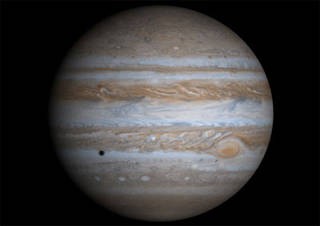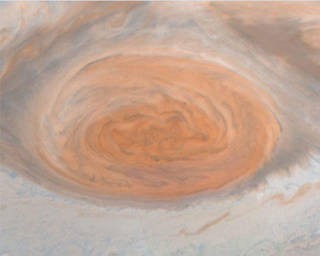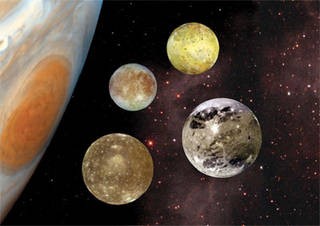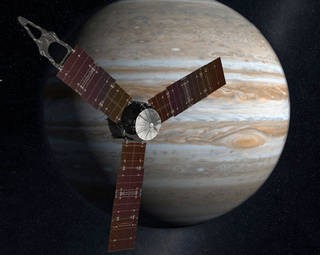
Jupiter is known for its stripes and large red spot.

The Galileo spacecraft took this photo of Jupiter's Great Red Spot in 1996.

Jupiter's four largest moons (Io, Europa, Ganymede and Callisto) are known as the Galilean satellites because they were discovered by Galileo Galilei in 1610.
Jupiter is the largest planet in the solar system. Jupiter is so big that all the other planets in the solar system could fit inside it. More than 1,300 Earths would fit inside Jupiter.
Jupiter is the fifth planet from the sun. From Earth, it is almost always the second brightest planet in the night sky. Venus is brighter. The planet is named after another Jupiter. He was the king of the gods in old Roman stories.
The planet Jupiter is not a solid like Earth is. Jupiter is made of gases. It is made of the same things that stars are made of. In fact, Jupiter would have become a star if it were about 80 times bigger.
What Is Jupiter Like?
The planet is a giant ball of gas. So Jupiter is called a "gas giant" planet. The planet is covered in thick red, brown, yellow and white clouds. The clouds make the planet look like it has stripes. Jupiter is very windy. Its winds blow more than 400 mph. That is faster than hurricanes and tornadoes!
Jupiter is famous for its Great Red Spot. The swirling, red spot is a giant spinning storm. It looks like a hurricane. Almost 3 1/2 Earths would fit across the storm.
Jupiter has three thin rings. Its rings are not like Saturn's rings. Jupiter's rings are hard to see. NASA’s Voyager 1 spacecraft found the rings in 1979. Jupiter’s rings are made up mostly of tiny bits of dust.
Jupiter rotates, or spins, faster than any other planet. Earth takes almost 24 hours to spin once. Jupiter only takes 10. So a day on Jupiter is about 10 hours long. It is so far from the sun that Jupiter takes 12 Earth years to make one trip around the sun. That means one year on Jupiter is 12 years on Earth.
It is very cold on Jupiter. Gravity is different, too. There is more gravity on Jupiter than on Earth. Someone who weighs 100 pounds on Earth would weigh about 240 pounds on Jupiter.
How Many Moons Does Jupiter Have?
Jupiter has 53 named moons. Scientists have discovered 14 more. But those 14 moons do not have official names. Scientists now think Jupiter has a total of 67 moons.
The last time a moon was found was in 2011. The planet’s four largest moons are Ganymede (GAN-i-meed), Callisto (kuh-LIS-toe), Io (eye-OH), and Europa (yur-O-puh). They were found long ago in 1610.
The largest of Jupiter’s moons is named Ganymede. It is the largest moon in the solar system. Ganymede is larger than Mercury and Pluto. The moon Callisto is covered with craters. The moon Io has a lot of volcanoes. Europa is covered with water ice.
How Has NASA Studied Jupiter?
NASA has studied Jupiter from Earth and from space. Some NASA scientists use telescopes on Earth to study Jupiter. The Hubble Space Telescope flies above Earth. It has taken pictures of Jupiter. From 1979 to 2007, eight NASA spacecraft studied Jupiter. Some of those spacecraft flew past the planet. Some stopped to visit. The missions studied the air and gases around Jupiter. Some missions studied the planet’s moons and rings. The missions took close-up pictures of some of the unusual things found on Jupiter.
How Is NASA Exploring Jupiter Today?
A new spacecraft is now at Jupiter. Its name is Juno. NASA’s Juno spacecraft launched in 2011. On July 4, 2016, Juno arrived at Jupiter. It did not land. It is flying around, or orbiting, Jupiter. Juno is taking the first pictures of Jupiter’s north and south poles.